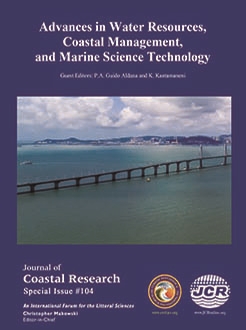Wang, J.P.; Liao, H.L.; Huang, H.P.; Zhang, R., and Sun, Q.Q., 2020. Discussion on the process of nitrification and denitrification by combining laboratory culture with dual isotope method in Lianhua River and Reservoir, Southeast China. In: Guido Aldana, P.A. and Kantamaneni, K. (eds.), Advances in Water Resources, Coastal Management, and Marine Science Technology. Journal of Coastal Research, Special Issue No. 104, pp. 486–491. Coconut Creek (Florida), ISSN 0749-0208.
As an indispensable part of water ecological nitrogen cycle, nitrification and denitrification play a crucial role in the process of nitrogen retention and release in river ecosystem. In order to certificate the nitrification and denitrification potential of surface water and sediment in different seasons and explain biogeochemical effects of nitrogen in a longitudinal gradient from upstream to downstream, we used lab culture and dual isotope tracing methods in Lianhua River and Reservoir, southeast China. The results show that the main sources of nitrate pollution in water body were NH4+ fertilizer, NO3- fertilizer, soil nitrogen, manure and waste water. Nitrification and denitrification processes mainly occur in sediment in river system. The potential ammonia nitrification rate (17.143∼171.429 µmol.m-2.h-1,) is significantly higher than that of nitrite oxidation rate (0.052∼2.267 µmol.m-2.h-1) which indicates that the biomass of AOB (Ammonia Oxidizing Bacteria) in sediment is higher than that of NOB (Nitrite Oxidizing Bacteria). Agricultural headwater river with relatively high organic nitrogen and low water level during winter dry season provides rich source of organic carbon and the anaerobic environment. Therefore, denitrification is more likely to occur in winter than in other seasons. Whereas, compared to the total potential nitrification rate (17.148∼173.223 µmol.m-2.h-1), total potential denitrification rate (2.224∼51.555 µmol.m-2.h-1) is not the dominant process especially in spring and summer, which illustrates that high nitrogen of the upstream water could cause certain potential risk to the eutrophication for the downstream of the reservoir.





